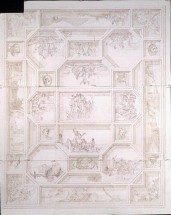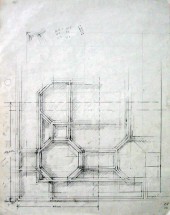| WorkBingham Ceiling
| Image Notes
Related work: Bingham Ceiling, 1991, Brown ink on paper, 70 x 58 inches.This work is a preparatory drawing for the 1993 painting, 70 x 58 inches, oil on canvas, with the same title.The drawing is on ten sheets of Arches paper which together equal 70 by 58 inches. The drawing is signed and dated lower right. Bingham Ceiling is reproduced in How To Paint A Vermeer by George Deem (2004 New York: Thames & Hudson, p. 93); and in the German edition,Täuschend echt: Die Kunst des Sehens (2004 Munich-Vienna, Sanssouci im Carl Hanser Verlag, p. 93); and in George Deem: The Art of Art History by David B. Dearinger (2012, Boston, Massachusetts, The Boston Athenaeum, p. 59). | Artist's Notes
Bingham Ceiling. About the work. When I was a child growing up in southern Indiana there were auditoriums on whose small stages public lectures and amateur theatricals and concerts of local choral groups took place. Those auditorium stages had fire curtains that rolled up and down like window shades and waiting for performances to begin one sat and looked at the fire curtains. They had unrelated scenes painted on them, landscapes and interiors, and the scenes were separated one from another by borders painted in brickwork and latticework designs and with leafy images of vines. There were also advertising messages with mingled words and images, and looking at those fire curtains was like looking at carnival posters with their pictures and with their lettering in black ink on ochre.These things came to mind when I was thinking about making a painting in which I would quote the paintings of the early 19th-century American artist George Caleb Bingham. His bright accomplished technique and stylized figures are, it seems to me, ancestors of those fire curtains and carnival posters. The latter however were more naive than what I had in mind. For a while I considered the composition of early altarpieces, numerous small images and scenes, each in its own compartment, its own space. Then one day in the Metropolitan Museum I happened upon a wood bed canopy identified as having been made in Florence between 1600 and 1625, the work of Cecco Bravo (Francesco Montelatici). Although it was hanging vertically on the wall, it was a canopy intended to be placed above a bed and had been made to be seen from below, like a ceiling. The canopy was organized symmetrically into panels separated by painted and gilded high wood dividers. The flat panels between the dividers were painted with individual scenes from the life of Christ, as in an altarpiece. I made a diagram of the bed canopy, recording the direction in which each scene faces within the symmetrically disposed whole. The arrangement of the Bingham paintings I chose to quote in my Bingham Ceiling follows the same directional plot. Working from the diagram I had made in the museum I determined through a number of drawings where I would place the Bingham paintings quoted in my painting. The high wood dividers separating the quoted paintings were to be painted in trompe-l'oeil, not constructed, and I studied how the shadows would fall from a light source at the left. My final drawings were on several sheets of paper which I pinned to the wall so that together they combined into one drawing the actual size of the canvas of my painting, 70 by 58 inches. Referring to this drawing on my studio wall I made the painting Bingham Ceiling, which I completed in 1993. (George Deem, New York, September 7th 1999).
| ExhibitionsSneed Gallery, Rockford, Illinois The Boston Athenaeum, Boston, Massachusetts
Capricorn Galleries, Bethesda, Maryland |
Works
| WorkBingham Ceiling
| Image Notes| Artist's Notes| Exhibitions |



